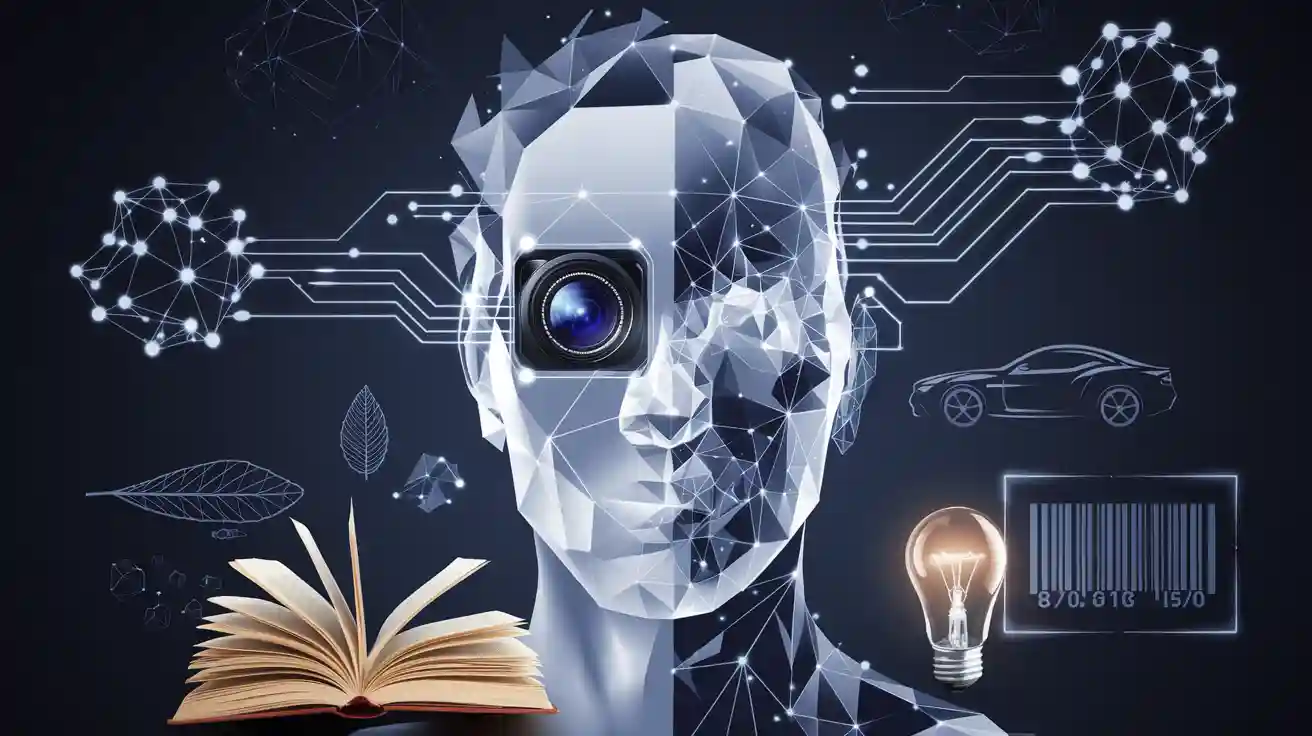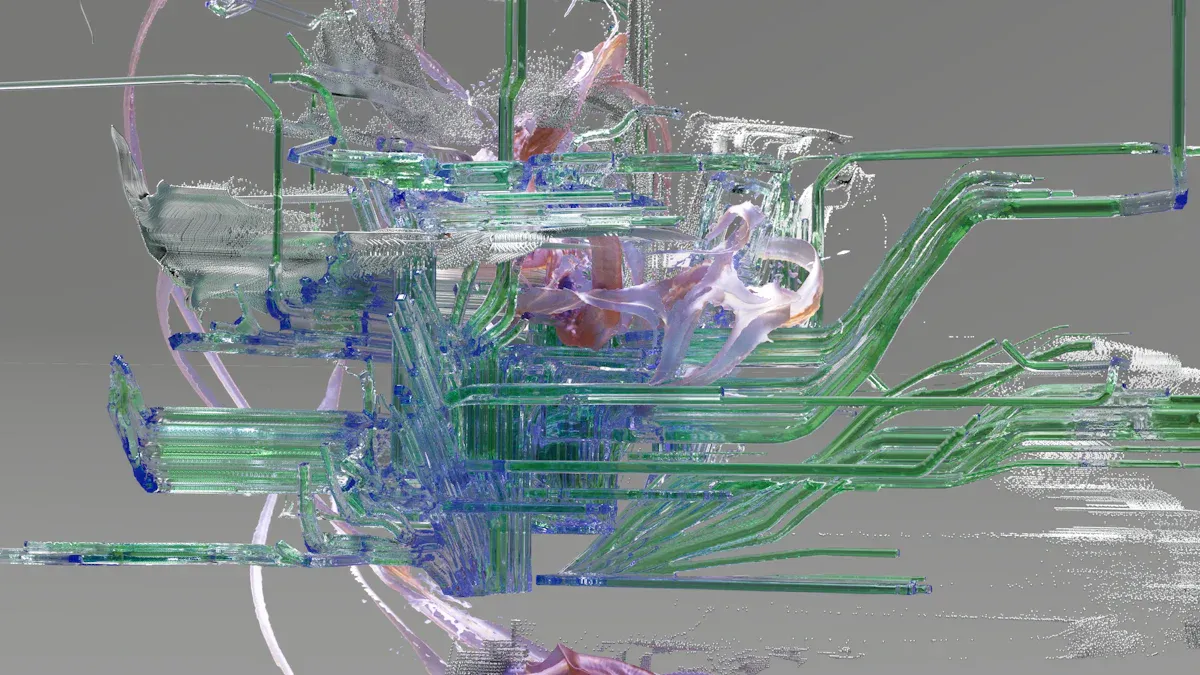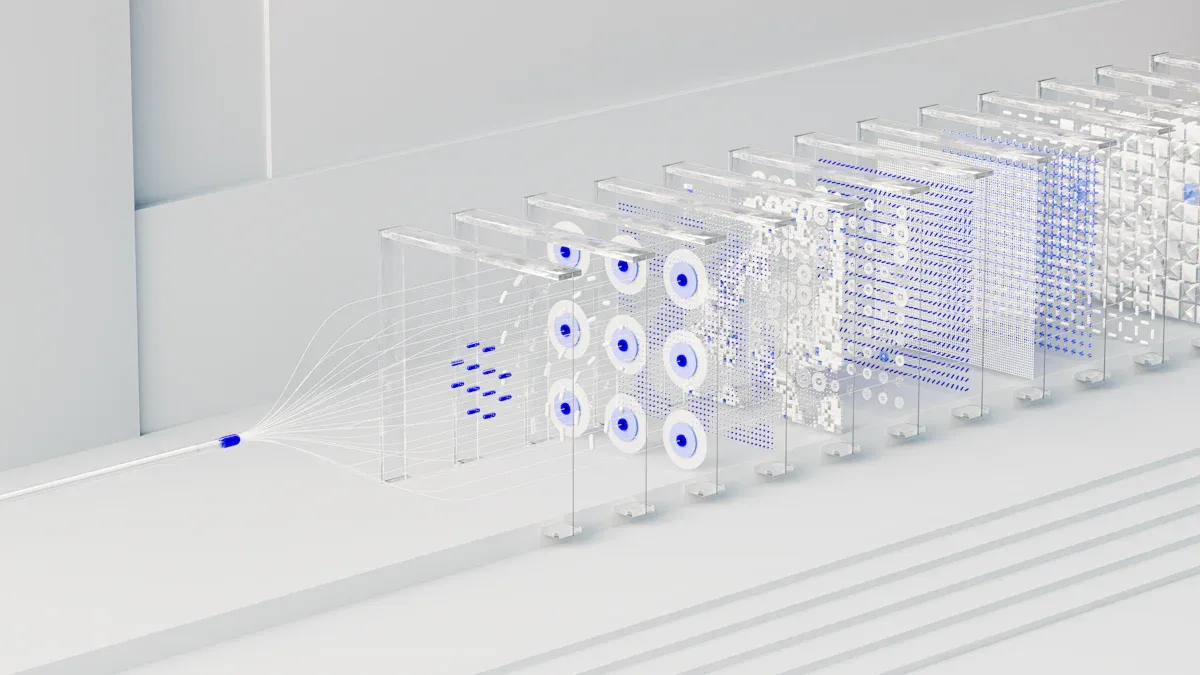
Unsupervised learning allows a computer vision system to discover patterns in unlabeled images. These systems learn to group similar items or spot rare differences without human help. Many computer vision tasks use unsupervised methods because labeled data often proves hard to find. Factories use these systems for detection of defects, and scientists use them for exploring new features in images. Unsupervised Learning machine vision system helps computers work smarter with less human input.
Key Takeaways
- Unsupervised learning helps computers find patterns in images without needing labels, making it ideal for large or unlabeled datasets.
- Key techniques like clustering and dimensionality reduction organize images and highlight important features, improving tasks like object detection and anomaly spotting.
- This approach saves time and resources by reducing the need for manual labeling and adapts well to new or changing data.
- Unsupervised learning supports real-world uses such as defect detection in factories, medical image analysis, and product inspection with less human effort.
- While powerful, unsupervised learning can be harder to interpret and evaluate, so combining it with supervised methods often yields the best results.
What Is It?
Unsupervised Learning Defined
Unsupervised learning is a type of machine learning that helps a computer find patterns in data without any labels. In machine vision systems, this means the computer looks at images and tries to group them or find differences on its own. The system does not know what each image shows before it starts. Instead, it learns by exploring the data and finding things that look similar or stand out. This approach works well when people do not have time or resources to label every image. Many computer vision tasks use unsupervised learning because it can handle large amounts of unlabeled data.
How It Works
Unsupervised learning in machine vision follows a clear process. The computer starts with raw images that have no labels. It then tries to find patterns or groups in the data. The system uses special techniques to do this, such as clustering or dimensionality reduction. These methods help the computer organize the images into groups or highlight important features. The final result often shows clusters of similar images or points out unusual items.
Here are the main steps in the process:
- The system takes in raw, unlabeled visual data.
- It looks for patterns in the data without any labels.
- The computer applies unsupervised learning techniques like clustering or dimensionality reduction.
- The system produces output, such as groups of similar images or highlighted features.
This process lets the computer learn from the data by itself. It can find hidden patterns that people might miss.
Unsupervised Learning vs. Supervised
Unsupervised learning and supervised learning are both types of machine learning, but they work in different ways. Supervised learning needs labeled data. Each image must have a label, like "cat" or "dog." The computer learns to match images to these labels. Unsupervised learning does not need any labels. The computer looks for patterns or groups in the data on its own.
The table below shows the main differences:
| Aspect | Supervised Learning | Unsupervised Learning |
|---|---|---|
| Data Requirements | Requires labeled data where each input has an output label | Works with unlabeled data without predefined labels |
| Outcome Types | Produces classification or regression results (e.g., object recognition in images) | Identifies patterns such as clustering, anomaly detection, or dimensionality reduction |
| Resource Demand | Requires significantly more resources due to labeling needs | Requires fewer resources, used to explore data structure without explicit guidance |
| Machine Vision Use | Used for tasks like object recognition and classification | Used for grouping or detecting anomalies in image data |
Unsupervised learning helps a computer vision system work with less human help. It can find new patterns and make sense of large sets of images. Supervised learning works best when people can provide many labeled examples. Both types play important roles in machine learning and computer vision.
Key Algorithms

Clustering Methods
Clustering helps machine vision systems group similar images or objects without labels. These clustering algorithms play a key role in unsupervised learning methods. They allow computers to organize data and find patterns in large image sets. The table below shows some of the most widely used clustering algorithms and their performance in machine vision tasks:
| Clustering Algorithm | Algorithm Type | Performance Highlights |
|---|---|---|
| GAL | Graph-based | Highest accuracy in benchmark; best overall with 28×28 + t-SNE (cosine distance) feature space; FM index 0.91 |
| GK | Spectral | Among top five performers in benchmark |
| J&W | Spectral | Most accurate spectral method among top five |
| GMM | Model-based (Gaussian Mixture Model) | Top five performer |
| OPTICS | Density-based | Included in top five performers |
Note: The choice of feature space, such as using t-SNE or UMAP, often affects clustering results more than the algorithm itself.
Clustering is often used in image segmentation. For example, a system can divide an image into regions with similar pixel values. This helps with object detection and image classification.
Dimensionality Reduction
Dimensionality reduction makes data analysis faster and more accurate. It removes extra or noisy information from images before processing. Techniques like Principal Component Analysis (PCA) and Linear Discriminant Analysis (LDA) help select the most important features. These methods speed up training and improve image classification results. In deep learning, dimensionality reduction is common in medical image diagnosis. It helps computers focus on the most useful parts of an image.
Some benefits include:
- Faster computation and training
- Better feature extraction
- Easier visualization of high-dimensional data
- Less risk of overfitting
Dimensionality reduction supports both segmentation and feature extraction in machine vision.
Association Techniques
Association techniques help find relationships between different features in images. These methods look for patterns that often appear together. For example, in image classification, association rules can link certain shapes or colors to specific objects. This helps the system learn which features belong together. Association techniques are useful in data analysis for discovering hidden connections in large image datasets.
Unsupervised Learning Machine Vision System

Pattern Recognition
An unsupervised learning machine vision system can recognize patterns in images without needing labeled data. The system looks for similarities and differences in visual features. It groups images that share common shapes, colors, or textures. This process helps with object detection and image classification. For example, in retail, the system can tell apart similar-looking products by learning their unique patterns. It can also support product recommendation and fraud detection by finding hidden connections between items.
In manufacturing, unsupervised learning helps machines spot patterns of good and faulty products. The system uses association rule learning to understand which features belong to normal items and which signal defects. This approach improves automation and accuracy in object detection tasks. Machines can now make better decisions by learning from large sets of unlabeled images.
Pattern recognition in unsupervised learning machine vision systems allows for faster and more flexible image recognition, even when labeled data is not available.
Anomaly Detection
Anomaly detection is a key application of unsupervised learning machine vision systems. The system learns what normal images look like and then finds outliers that do not fit the usual pattern. These outliers often signal defects or problems. In industrial settings, the system uses generative models like autoencoders and GANs to rebuild normal images. If the system cannot reconstruct an image well, it marks it as an anomaly.
Unsupervised learning machine vision systems also use Siamese networks to compare normal and test samples. The system activates when it finds a difference, making it easier to spot unknown defects. This method works well when defect samples are rare or defects appear in many forms. Factories use these systems for gear machining inspection, battery tab weld inspection, and flexible plastic packaging inspection. These real-world applications show how unsupervised learning helps detect problems early and keeps quality high.
Visual Inspection
Visual inspection is another important application of unsupervised learning machine vision systems. The system checks products or materials for defects without needing many labeled examples. In industries like food safety, the system can find spoilage or contamination by spotting unusual patterns in images. It uses statistical analysis to compare normal and abnormal samples in high-dimensional feature spaces.
Some unsupervised learning machine vision systems use meta-learning to handle many types of defects. For example, Model-Agnostic Meta-Learning (MAML) trains the system on different defect detection tasks. This training helps the system adapt to new problems quickly. Visual inspection systems also use dual-stream channels to highlight differences between normal and defective samples.
Real-world application of unsupervised learning machine vision systems includes stator core inspection, syringe final inspection, and counterfeit detection. These systems improve decision-making and reduce the need for human checks.
Unsupervised learning machine vision systems play a big role in modern industries. They support object detection, anomaly detection, and image classification. These systems help companies find defects, recognize objects, and inspect products with less human effort. As a result, they make production lines smarter and more reliable.
Benefits and Limits
Advantages
Unsupervised learning in machine vision systems offers several important benefits. These systems do not need labeled data, which saves time and money. People can use large sets of images without spending hours labeling each one. This makes the technology useful in fields where labeled data is hard to get, such as medical imaging or industrial inspection.
Unsupervised learning can find hidden patterns in images. The system groups similar items and spots rare differences. This helps companies discover new trends or detect problems early. The technology adapts well to new data. When new images arrive, the system can learn from them without extra work. This flexibility improves the overall performance of machine vision systems.
Tip: Unsupervised learning works best when people want to explore data or find unknown issues.
Challenges
Unsupervised learning also has some limits. These systems can be hard to understand. People may not know why the system grouped certain images together. This lack of interpretability can make it difficult to trust the results.
Evaluating the results of unsupervised learning can be tricky. There are no labels to check if the system made the right choice. People must use special tests or visual checks to measure performance. Sometimes, unsupervised learning gives less precise results than supervised learning. The system may miss small details or make mistakes when patterns are not clear.
| Challenge | Description |
|---|---|
| Interpretability | Hard to explain why the system made a decision |
| Evaluation | No labels make it tough to measure accuracy |
| Precision | May not match the performance of supervised methods |
Unsupervised learning helps machine vision systems handle large, unlabeled datasets, but users must understand its limits.
Machine Learning in Vision
When to Use Unsupervised Learning
Unsupervised learning plays a key role in machine learning for computer vision. Many vision tasks involve large sets of images without labels. In these cases, unsupervised methods help computers find patterns and group similar images. People often choose unsupervised learning when labeled data is hard to get or too expensive to produce. This approach works well for exploring new datasets or finding hidden structures in visual data.
Some common scenarios where unsupervised learning is preferred include:
- Labeled data is scarce, ambiguous, or difficult to obtain.
- The goal is to discover hidden patterns or group similar data points.
- The dataset is very large, making manual labeling impractical.
- The application involves exploratory analysis or anomaly detection.
- The cost or complexity of labeling is too high.
Clustering and dimensionality reduction help computers reveal important features in images. These methods allow machine learning systems to organize data and support applications like anomaly detection and pattern discovery. Unsupervised learning gives computer vision systems the flexibility to work with new or unknown data.
Tip: Unsupervised learning is a strong choice for applications where labeled examples are unavailable or expensive to produce.
Combining with Supervised Methods
Hybrid approaches in machine learning combine the strengths of unsupervised and supervised methods. These advanced systems use techniques like self-supervised learning to generate pseudo-labels from unlabeled data. This process helps computers learn structured representations without needing many labeled examples.
Emerging trends in machine learning for computer vision include:
- Self-supervised learning bridges the gap between unsupervised and supervised learning.
- Hybrid models use symbolic AI and deep learning to automate data categorization.
- Integration with few-shot and zero-shot learning improves classification of unseen categories.
- Pretext tasks such as contrastive learning and masked image modeling enhance feature representation.
- These methods reduce the need for costly human annotation, making solutions scalable.
Applications in autonomous driving and medical imaging show how these trends improve performance. For example, self-supervised learning boosts tumor segmentation accuracy and object detection in complex environments. As these hybrid methods grow, ethical considerations and transparency become more important to ensure fairness and accountability.
Unsupervised learning helps machine vision systems find patterns and detect anomalies without labeled data. Algorithms like clustering and dimensionality reduction support tasks such as object classification and visual inspection. Recent advances, including STEGO, allow machines to label images at the pixel level and handle complex scenes. Future research explores richer data types and synthetic datasets to improve automation.
Those interested in applying these techniques can start by learning Python, using tools like scikit-learn, and practicing with real datasets. Building a project portfolio and joining online courses will help deepen skills.
FAQ
What is the main goal of unsupervised learning in machine vision?
Unsupervised learning helps computers find patterns or groups in images without labels. The system learns by itself. This makes it useful for tasks where people cannot label every image.
Can unsupervised learning detect new or rare defects?
Yes. Unsupervised learning can spot rare or new defects by finding images that look different from normal ones. This helps factories catch problems early.
Which industries use unsupervised learning in machine vision?
Many industries use it, including manufacturing, healthcare, food safety, and retail. These systems help with quality checks, medical image analysis, and product sorting.
Is unsupervised learning better than supervised learning?
Each method has strengths. Unsupervised learning works well with unlabeled data and finds hidden patterns. Supervised learning gives more precise results when labeled data is available.
Tip: Use unsupervised learning when labeled data is hard to get or when exploring new image datasets.








